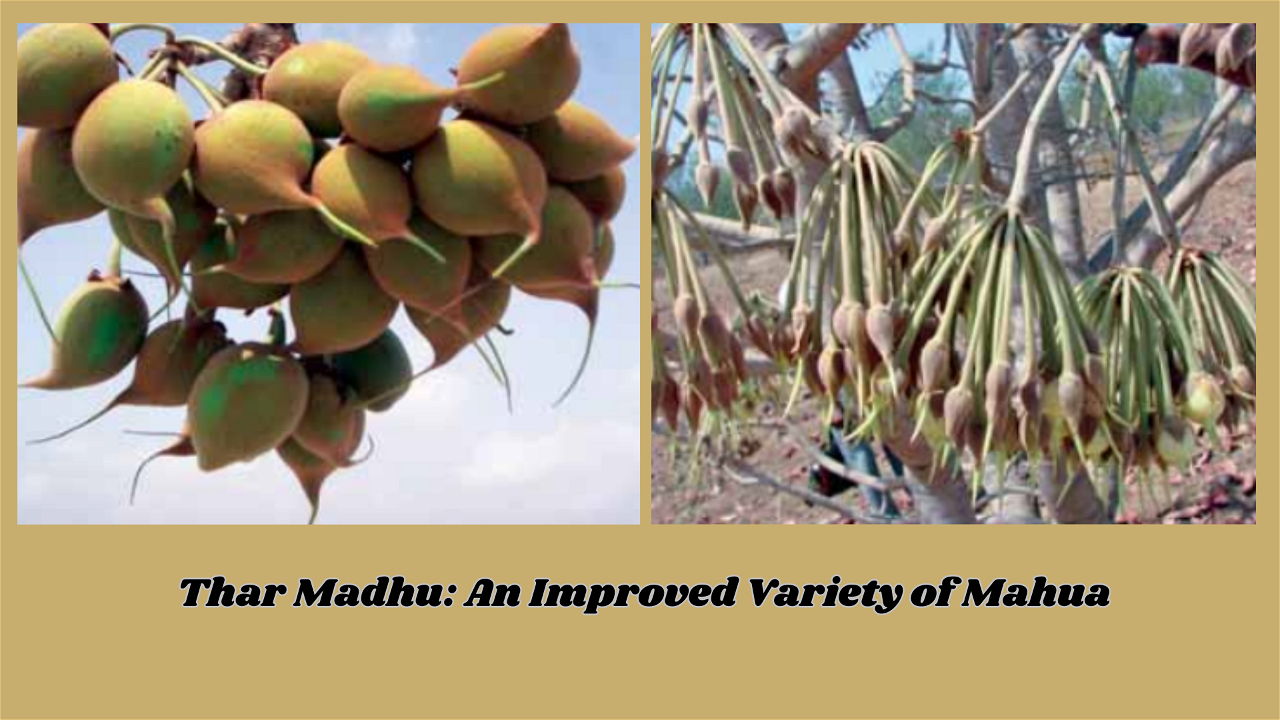
Thar Madhu is a new variety of mahua, a significant tree in the arid regions of India. Developed by the Central Institute for Arid Horticulture, Bikaner, this variety was identified in 2016 and has shown remarkable potential in terms of flowering, fruiting, and fruit quality.
Key Characteristics of Thar Madhu:
-
Tree Growth: Thar Madhu exhibits a spreading growth pattern with a tree height of approximately 4.42 meters and a rootstock girth of 72.21 cm. Its spread is around 3.45 meters north-south and 3.67 meters east-west. The leaves are coriaceous, elliptic or elliptic-oblong, and change from pubescent to glabrous with age.
-
Flowering: The grafted Thar Madhu plants begin flowering in their 5th year, typically in March. The flowers are bisexual and have a diameter of 6.11 mm. Peak flowering occurs from midnight to morning, with cross-pollination essential for fruit setting. The flowering period is marked by a high number of flowers per fascicle, averaging 38.14.
-
Fruit Quality: Thar Madhu produces fruits that ripen in May. Fresh flowers have a Brix TSS of 26.63°, 1.03% acidity, 23.11% total sugar, and 58.61 mg/100g vitamin C. The dry flower yield is about 6.32 kg per plant. The fruits have an average weight of 29.00 grams, with 41.74% pulp, a Brix TSS of 14.26°, 0.10% acidity, 10.80% total sugar, and 48.38 mg/100g vitamin C. The fruit yield reaches up to 20.14 kg per plant by the 10th year under rainfed conditions.
Production Technology
-
Soil and Climate: Mahua thrives in a variety of soil types, including rocky, gravelly red soils and saline or sodic soils. For optimal growth, well-drained, deep loam soil is ideal. The plant is well-suited to semi-arid and arid conditions.
-
Propagation: Mahua can be propagated through softwood grafting. Grafting involves using 15-20 cm long mature shoots and requires careful handling to ensure high success rates. In-situ grafting, performed directly in the field, offers better plant growth and survival rates.
-
Orchard Establishment: For orchard planting, dig pits of 90 × 90 × 90 cm and prepare the soil by separating and exposing it to weather. Mix well-decomposed organic matter into the soil before planting. Ensure the plants are irrigated and protected from temperature extremes during the initial years.
-
Canopy Management: Manage the canopy by allowing 3-5 well-spaced branches to develop. This helps in maintaining the desired size and shape of the tree.
-
Mulching: Use organic materials like paddy straw or grasses for mulching. This practice conserves soil moisture, moderates temperature fluctuations, reduces evaporation, and enhances plant growth.
-
Irrigation and Nutrient Management: While mahua is resilient and can survive on rainwater, irrigation is necessary during the first 2 years of growth. Apply farmyard manure and a balanced fertilizer regimen to support healthy plant development.
Harvesting and Post-Harvest Management
-
Harvesting: Harvest mahua flowers in May-June when they fall from the tree. Collect and dry them on polythene sheets to prevent moisture-related issues. Store dried flowers in thin layers and in a dry place.
-
Seed Handling: Extract seeds from ripe fruits and shelve them within a week to prevent germination. Dry the kernels to a moisture content of 8% to avoid fungal attacks. These dried kernels are used for oil extraction.
(Source: Drs Sanjay Singh, A. K. Singh, V. V. Apparao and R Bhargava (Scientists), Central Horticultural Experiment Station, Indian Horticulture, July July–August 2016, 27-29)
















